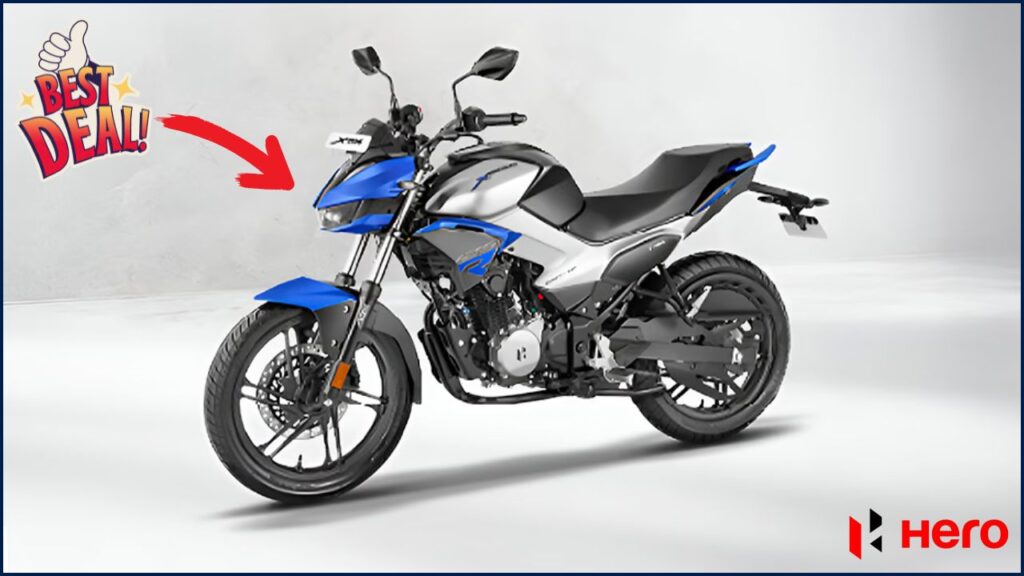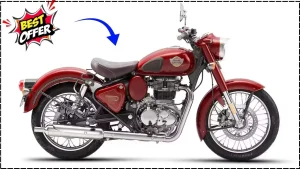
Hero MotoCorp, India’s largest two-wheeler manufacturer, has introduced a major festive season offer, pricing select Hero 125cc bikes at ₹54,999 (ex-showroom) in specific markets. Announced in the last week of October, the offer is already drawing large crowds to dealerships nationwide. The strategy is expected to boost sales in the critical festive quarter, when auto purchases traditionally surge.
Table of Contents
A Landmark Price Drop in the 125cc Segment
Hero MotoCorp confirmed that the ₹54,999 price tag applies to select base variants of its 125cc commuter motorcycles, including the Super Splendor 125 and parts of the Glamour 125 lineup. The offer is available in select Tier-2 and Tier-3 cities, covering regions across Uttar Pradesh, Uttarakhand, Rajasthan, Bihar, and parts of Madhya Pradesh.
The company called the move “a targeted initiative to make personal mobility more affordable.” It comes amid a competitive market environment and a steady recovery in two-wheeler demand following a pandemic-driven slowdown.
“Our festive offer reflects Hero MotoCorp’s commitment to making personal mobility more accessible and affordable,” said a company spokesperson in a press statement. “We aim to support rising mobility needs in growing urban and rural centers.”
Why This Price Matters
Breaking the Psychological Barrier
For many Indian consumers, especially in price-sensitive rural and semi-urban markets, the ₹60,000 threshold is psychologically significant. Two-wheelers priced below this line tend to attract first-time buyers, students, delivery workers, and families looking for economical transport.
According to data from the Society of Indian Automobile Manufacturers (SIAM), motorcycles in the 110–125cc category account for nearly 28% of total two-wheeler sales in India. Lowering the entry price could give Hero a strategic edge over rivals such as Bajaj Auto, TVS Motor, and Honda Motorcycle & Scooter India.
“This is not just a discount; it’s a signal to the market,” explained Dr. Anil Mehta, auto industry analyst at the Indian Institute of Management Ahmedabad (IIMA). “Sub-₹60,000 pricing is rare for new 125cc models today. Hero is positioning itself to capture both first-time buyers and those upgrading from a scooter or a lower engine displacement bike.”
Industry Context: Competitive Pressures and Market Timing
Festive Quarter as a Strategic Battleground
October to December is traditionally the strongest quarter for vehicle sales in India, fueled by festivals such as Dussehra and Diwali. Manufacturers often offer cash discounts, exchange bonuses, and easy financing to accelerate volumes.
However, industry observers say Hero’s price cut is more aggressive than typical festive promotions. Most major OEMs have limited discounts to ₹3,000–₹7,000, while Hero’s pricing effectively places the base variant ₹15,000–₹20,000 below its standard price in many cities.
“This is a decisive play to defend market share,” said Rajeev Sinha, Senior Auto Consultant at CRISIL. “Hero has a strong dealership network in rural India. By undercutting rivals, they may pull back customers who were considering other brands or delaying purchases.”
Hero 125cc Bike Financing and Affordability: Making Ownership Easier
Flexible Schemes and Low EMIs
Hero dealers have tied the promotion to zero or low down-payment offers, as well as EMIs starting at around ₹1,800 per month through leading NBFCs and banks. For many households, this lowers the entry barrier significantly.
Dealers say they’ve already seen a 30% increase in financing queries compared to last month.
“Buyers today are more EMI-driven than cash-driven,” said Sunita Verma, a dealership manager in Dehradun. “The combination of lower upfront price and easy credit is driving footfall.”
This strategy aligns with broader trends: According to a Reserve Bank of India (RBI) report on consumer credit, two-wheeler financing volumes rose 15% year-on-year in the last quarter.
Model Variants and Features
The promotional offer primarily applies to the Super Splendor 125 Drum variant, known for its fuel efficiency, reliability, and low maintenance cost. The model features a 124.7cc air-cooled engine, 5-speed gearbox, and i3S idle stop-start system for improved mileage.
Hero is also offering discounts on select Glamour 125 variants, though the pricing is not uniform across all locations. Dealerships have been instructed to inform customers about on-road cost differences depending on state taxes, insurance, and registration fees.
Consumer Reactions and Buying Patterns
Surge in First-Time Buyers
Early data from select dealerships shows a sharp rise in bookings and test rides. A large portion of these are first-time buyers or customers upgrading from 100cc commuter bikes.
“We’ve had customers who were planning to buy a used two-wheeler, now opting for a new one,” said Verma. “Price matters a lot in this segment.”
Customers, however, are advised to clarify hidden costs such as insurance premiums, handling charges, and optional accessories, which can increase the on-road price by ₹8,000 to ₹12,000.
The Broader Economic Picture
Inflation, Costs, and Strategic Pricing
Over the last three years, rising input costs, including steel and electronic components, combined with stricter emission standards (BS-VI), have pushed entry-level motorcycle prices steadily upward. A 125cc bike that cost ₹55,000 in 2018 now averages ₹85,000–₹95,000.
This steep inflation has narrowed the affordability window for lower-income households. Hero’s temporary discount directly addresses that gap.
“This is smart timing,” said Mehta of IIMA. “By absorbing part of the cost burden, Hero is stimulating demand when rural incomes are showing early signs of recovery after a difficult period.”
Electric Vehicles vs. ICE: A Subtle Undercurrent
While electric two-wheelers are growing in India, their average price remains significantly higher, often starting above ₹90,000. Charging infrastructure also remains limited in rural areas, making internal combustion engine (ICE) motorcycles a practical choice for millions.
According to NITI Aayog, EV two-wheeler penetration was just 5% in FY2024, with most sales concentrated in urban centers. Hero’s move is seen as a defensive strategy to retain ICE market dominance even as the EV transition accelerates.
“EVs are coming, but not fast enough to displace ICE motorcycles in rural India,” explained Sinha of CRISIL. “Hero is reinforcing its base.”
Regional Strategy: Why Tier-2 and Tier-3 Cities Matter
Hero MotoCorp has one of the largest rural dealership networks in the country. Its distribution strategy has historically leaned on these markets, where financing penetration is growing and demand for affordable mobility is strong.
By focusing this offer outside metros, Hero is targeting buyers who value affordability over premium features. Analysts expect similar pricing strategies to appear in states like Chhattisgarh, Odisha, and Jharkhand in the coming weeks.
Buying Guide: How Consumers Can Maximise the Offer
For buyers considering the offer, experts recommend:
- Verifying variant and availability at the local dealership.
- Comparing on-road prices across nearby cities, as taxes vary.
- Reading the fine print of financing agreements carefully.
- Checking for insurance add-ons that may not be mandatory.
- Booking early, as the offer is valid only on limited stock.
Outlook: Could This Trigger a Price War?
Industry watchers say Hero’s strategy may pressure competitors to roll out their own festive discounts. Bajaj and TVS have historically avoided deep cuts on their 125cc lineup, preferring financing deals. But Hero’s bold pricing could force a rethink.
If demand spikes, short-term gains in market share are likely. But analysts warn that sustained discounts can erode margins if not balanced with volume growth.
“It’s a calculated risk,” said Sinha. “If others match Hero, the segment could see a temporary price war, benefiting consumers.”
Yamaha Rajdoot 2025 with 273cc Engine and 110 km/h Speed: Massive Launch Discount Announced
Conclusion
Hero MotoCorp’s decision to price its 125cc bike at ₹54,999 is more than a festive discount — it is a strategic statement. In a market where affordability, competition, and evolving consumer habits intersect, this move may help the company consolidate its leadership in the commuter segment.
Whether this sparks a broader pricing shift or remains a seasonal strategy will depend on how consumers and competitors respond in the coming weeks.















